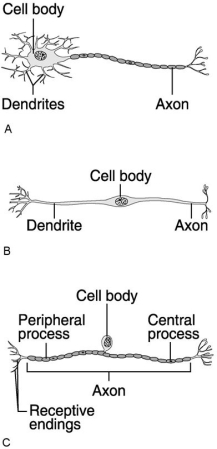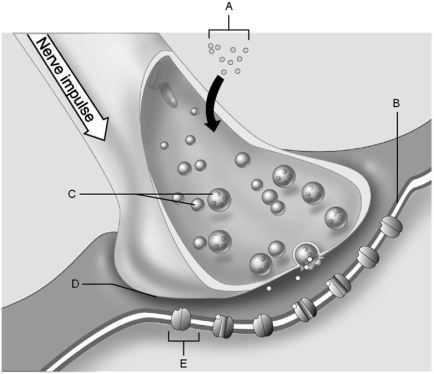A) inability to destroy and remove acetylcholine from the synaptic cleft
B) stimulation of the production of acetylcholine
C) amplify or enhance the effect of ACh
D) inability to release acetylcholine
Correct Answer

verified
Correct Answer
verified
Multiple Choice
 Figure 11.1
Using Figure 11.1, match the following:
-Which neuron is never myelinated?
Figure 11.1
Using Figure 11.1, match the following:
-Which neuron is never myelinated?
A) C
B) B
C) A
Correct Answer

verified
Correct Answer
verified
True/False
The all-or-none phenomenon as applied to nerve conduction states that the whole nerve cell must be stimulated for conduction to take place.
Correct Answer

verified
Correct Answer
verified
True/False
Axon diameter and degree of myelination determine nerve impulse conduction velocity.
Correct Answer

verified
Correct Answer
verified
Multiple Choice
Nerve impulses leading to the brain carry information about cool temperatures on the skin.The nerve fibers sending these signals will most likely belong to which division of the nervous system?
A) sensory (afferent) division
B) somatic nervous system
C) sympathetic division
D) parasympathetic division
Correct Answer

verified
Correct Answer
verified
Multiple Choice
 Figure 11.1
Using Figure 11.1, match the following:
-Which neuron is common only in dorsal root ganglia of the spinal cord and sensory ganglia of cranial nerves?
Figure 11.1
Using Figure 11.1, match the following:
-Which neuron is common only in dorsal root ganglia of the spinal cord and sensory ganglia of cranial nerves?
A) C
B) B
C) A
Correct Answer

verified
A
Correct Answer
verified
Multiple Choice
Match the following: -May be involved in complex,exacting types of mental processing.
A) Parallel after-discharge circuit
B) Reverberating circuit
C) Diverging circuit
D) Converging circuit
Correct Answer

verified
Correct Answer
verified
Multiple Choice
The term central nervous system refers to the ________.
A) brain and spinal cord
B) sensory (afferent) nerves
C) the somatic nerves
D) the spinal nerves
Correct Answer

verified
A
Correct Answer
verified
Short Answer
The synapse more common in embryonic nervous tissue than in adults is the ________.
Correct Answer

verified
Correct Answer
verified
Multiple Choice
Which of the following is not characteristic of neurons?
A) They have an exceptionally high metabolic rate.
B) They conduct impulses.
C) They have extreme longevity.
D) They are mitotic.
Correct Answer

verified
Correct Answer
verified
Multiple Choice
Which of the following will occur when an excitatory postsynaptic potential (EPSP) is being generated on the dendritic membrane?
A) Sodium gates will open first, then close as potassium gates open.
B) A single type of channel will open, permitting simultaneous flow of sodium and potassium.
C) Specific sodium gates will open.
D) Specific potassium gates will open.
Correct Answer

verified
Correct Answer
verified
Short Answer
That part of the nervous system that conducts impulses from the CNS to the skeletal muscles is the ________ nervous system.
Correct Answer

verified
Correct Answer
verified
Essay
What are the basic divisions of the peripheral nervous system?
Correct Answer

verified
Sensory and motor divisions.Sensory has two divisions: the somatic and visceral.Motor has two divisions: the somatic and autonomic.The autonomic has two divisions: the sympathetic and parasympathetic.
Correct Answer
verified
True/False
Enkephalins and endorphins are peptides that act like morphine.
Correct Answer

verified
Correct Answer
verified
Multiple Choice
A second nerve impulse cannot be generated until ________.
A) all sodium gates are closed
B) the membrane potential has been reestablished
C) the Na ions have been pumped back into the cell
D) proteins have been resynthesized
Correct Answer

verified
Correct Answer
verified
Multiple Choice
Select the correct statement regarding chemical synapses.
A) The synaptic cleft uses the action potential to transmit a chemical signal to the post synaptic cell.
B) The release of neurotransmitter molecules gives cells the property of being electrically coupled.
C) Cells with gap junctions use chemical synapses.
D) Neurotransmitter receptors are located on the axons terminals of cells.
Correct Answer

verified
Correct Answer
verified
True/False
Reflexes are rapid,automatic responses to stimuli that will produce the same effect every time.
Correct Answer

verified
Correct Answer
verified
True/False
Cell bodies of sensory neurons may be located in ganglia lying outside the central nervous system.
Correct Answer

verified
Correct Answer
verified
Multiple Choice
Schwann cells are functionally similar to ________.
A) astrocytes
B) microglia
C) ependymal cells
D) oligodendrocytes
Correct Answer

verified
Correct Answer
verified
Multiple Choice
 Figure 11.2
Using Figure 11.2, match the following:
-Calcium ions.
Figure 11.2
Using Figure 11.2, match the following:
-Calcium ions.
A) C
B) E
C) B
D) D
E) A
Correct Answer

verified
Correct Answer
verified
Showing 1 - 20 of 95
Related Exams